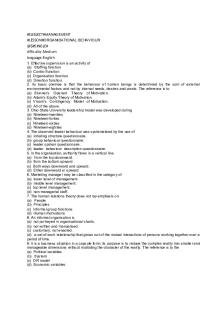L5 - Organisational Tasks and Organisational Design PDF

| Title | L5 - Organisational Tasks and Organisational Design |
|---|---|
| Course | Organisational Behaviour |
| Institution | Loughborough University |
| Pages | 6 |
| File Size | 397 KB |
| File Type | |
| Total Downloads | 25 |
| Total Views | 138 |
Summary
Professor Ken Eason...
Description
Week 5 – Organisational Tasks and Organisational Design The Leavit Diamond
-
Task: primary task leads to smaller tasks Structure: so resources are all directed to the task
-
‘Organisations have to live in their turbulent environments’ have to adapt to ever-changing circumstances continually trying to optimise be ready to change organisational design
The Assumption of Division of Labour and Command and Control
Primary tasks gets split from top to bottom into simpler, easier tasks
A lot of organisations are set up this way
Higher jobs co-ordinate & control tasks
E.g., Ford: making cars is complicated, so split tasks into smaller, simpler tasks
Week 5 – Organisational Tasks and Organisational Design Production Technology and Organisation Woodward (1965)
Study looked at organisational structure and found not all successful companies in 1960’s fragmented overall task and created a hierarchy to co-ordinate the activity Unit production: E.g. furniture making Craftsmen told by managers what was needed and got on with it Mass production: E.g. factory work Lots of people & production so required co-ordination, control, hierarchy & rules Process production: E.g. electricity generation Front-line jobs in control rooms with few specialised staf Tall hierarchy but with not many people at each level
Concluded: need to look at technology to determine type of work, number of employees, and therefore organisational structure Contingency theory If there is no one best way to structure an organisation:
What are the alternative structures, and What factors determine when to use them?
Possible factors: 1. The technology (Woodward, 1965) 2. The environment (Burns & Stalker, 1961) - Stable – mechanistic structures - Variable – organic structures 3. The organisational task (Thompson, 1965) The Dutch approach: Integral Organisational Renewal (IOR) De Sitter et al. (1997) From: complex organisations with simple jobs To: simple organisations with complex jobs
Week 5 – Organisational Tasks and Organisational Design Technology and Organisation: The Assumption of Technological Determinism
Technology has inevitable efects on the work people do, and the structure - E.g., if you have to transport people by bus, you need bus drivers
Ahmedabad Textile Mills Rice (1958)
Symptoms: - New semi-automatic looms But - Low quality and output
Organisational Analysis: 1. Task Specialisation – 12 separate jobs 2. Reporting – all to Supervisor 3. Task Performance – complex interaction 4. No identification with completed task
Text mill before change -
Communication problems as every person is in demand a lot of the time
-
Led to low quality & low output
Text mill after change -
Small group of 7 workers who between them could do everything required to keep a group of looms running
-
No need to call for help outside of team
Week 5 – Organisational Tasks and Organisational Design Results
First seven months: - Worked well, decline in performance for technical and mechanical reasons - Experiment adjusted
Subsequently: Efficiency increased from 80 to 90% Damage reduced from 32 to 20% Wages increased, costs cut
Theoretical conclusions: - Interdependence of technical and social systems - There is no ‘technical determinism’ - There is ‘organisational choice’ - Semi-autonomous working groups for interdependent tasks
Socio-Technical Systems Theory Rice, Trist & Emery (1950-1970)
Inputs (e.g. wool etc.) are processed to create outputs (e.g. clothes) Social: workers etc. Tech: machinery etc. Have to work out what works best
Semi-Autonomous Work Groups (SAWGs) A group at work of (optimum) 6 - 8 members: -
Given collective responsibility for a large independent task With autonomy over their methods, allocations of duties etc. With multi-skilled group members enabling flexible allocation And some element of reward based on group performance
-
Example: assembly cells in Volvo and Saab car assembly plants
Designing a Socio-Technical System: Task Interdependence and Structure
Week 5 – Organisational Tasks and Organisational Design Thompson (1967)
Pooled: diferent people could do own work without direct efect upon one another but still utilise same pool of resources Sequential: one person’s work passed onto one another and another. E.g. assembly line Reciprocal: getting job done means other people have to work together Organisational structures need to reflect task interdependencies Task Interdependencies and Work Roles
Some parts of an org may have sequential interdependencies, parallel interdependencies and some relatively interdependent work Socio-Technical system reflects this Semi-Autonomous Work Groups (SAWG)
Organisational Design Issues for the Bus Company
Task Interdependencies – routes: ‘all the buses come at once’ – team work and communication Division of Labour – might be assumed to be ‘given’ i.e. rigid distinctions between drivers, maintenance staf, ‘back office’ staf, supervisors etc
Week 5 – Organisational Tasks and Organisational Design
Flexibility – need all your resources for the rush hour: flexible allocation of resources Technology – manning buses, communications, scheduling etc, all have implications for workforce deployment....
Similar Free PDFs

Organisational structure
- 3 Pages

Organisational Communication
- 3 Pages

Organisational feasibility
- 2 Pages

Organisational Behaviour
- 26 Pages

Organisational behaviour
- 1 Pages

Organisational Rights
- 4 Pages

Lec+2-+Organisational+Behaviour
- 22 Pages

Organisational Behaviour Notes
- 9 Pages

Organisational Behaviour MCQ
- 121 Pages

Assignment 3 Organisational Analysis
- 10 Pages
Popular Institutions
- Tinajero National High School - Annex
- Politeknik Caltex Riau
- Yokohama City University
- SGT University
- University of Al-Qadisiyah
- Divine Word College of Vigan
- Techniek College Rotterdam
- Universidade de Santiago
- Universiti Teknologi MARA Cawangan Johor Kampus Pasir Gudang
- Poltekkes Kemenkes Yogyakarta
- Baguio City National High School
- Colegio san marcos
- preparatoria uno
- Centro de Bachillerato Tecnológico Industrial y de Servicios No. 107
- Dalian Maritime University
- Quang Trung Secondary School
- Colegio Tecnológico en Informática
- Corporación Regional de Educación Superior
- Grupo CEDVA
- Dar Al Uloom University
- Centro de Estudios Preuniversitarios de la Universidad Nacional de Ingeniería
- 上智大学
- Aakash International School, Nuna Majara
- San Felipe Neri Catholic School
- Kang Chiao International School - New Taipei City
- Misamis Occidental National High School
- Institución Educativa Escuela Normal Juan Ladrilleros
- Kolehiyo ng Pantukan
- Batanes State College
- Instituto Continental
- Sekolah Menengah Kejuruan Kesehatan Kaltara (Tarakan)
- Colegio de La Inmaculada Concepcion - Cebu





